Microscope manufacturer Samuel Highley was credited by Lionel Smith Beale as being one of “the first makers in London who brought out a really good, cheap, practical instrument”. Highley designed several innovative, award-winning microscopes and associated apparatus. He is first known to have sold microscopes in 1853, and his business appears to have shut down shortly after 1870.
Highley was also a leader in the use of the projection lantern (“magic lantern”) for educational purposes, rather than just for entertainment. He made several advances in this technology. He was a skilled photographer, and a member of the Geological Society and the Chemical Society. On top of that, he was a prolific author on a range of subjects. A biography of Highley follows Figure 12.

Figure 1.
Highley’s “Hospital” microscope, ca. 1853. The engraving is from Currey’s translation of Schacht’s “The Microscope”, 1853. The image of the extant microscope is adapted for nonprofit, educational purposes from https://www.mhs.ox.ac.uk/collections/imu-search-page/record-details/?thumbnails=on&irn=12857&TitInventoryNo=83729. It is also shown in Turner’s “Great Age of the Microscope” as item 83, on pages 96-97.
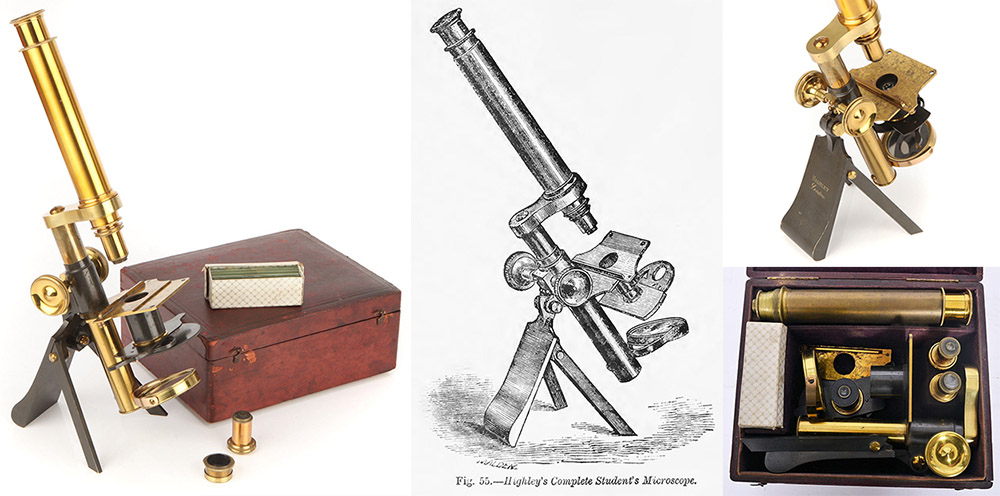
Figure 2.
Highley’s “Student’s” microscope, ca. 1867. The engraving is from “The British Medical Journal”, 1867. The images of the surviving instrument are adapted for nonprofit, educational purposes from an internet auction site.
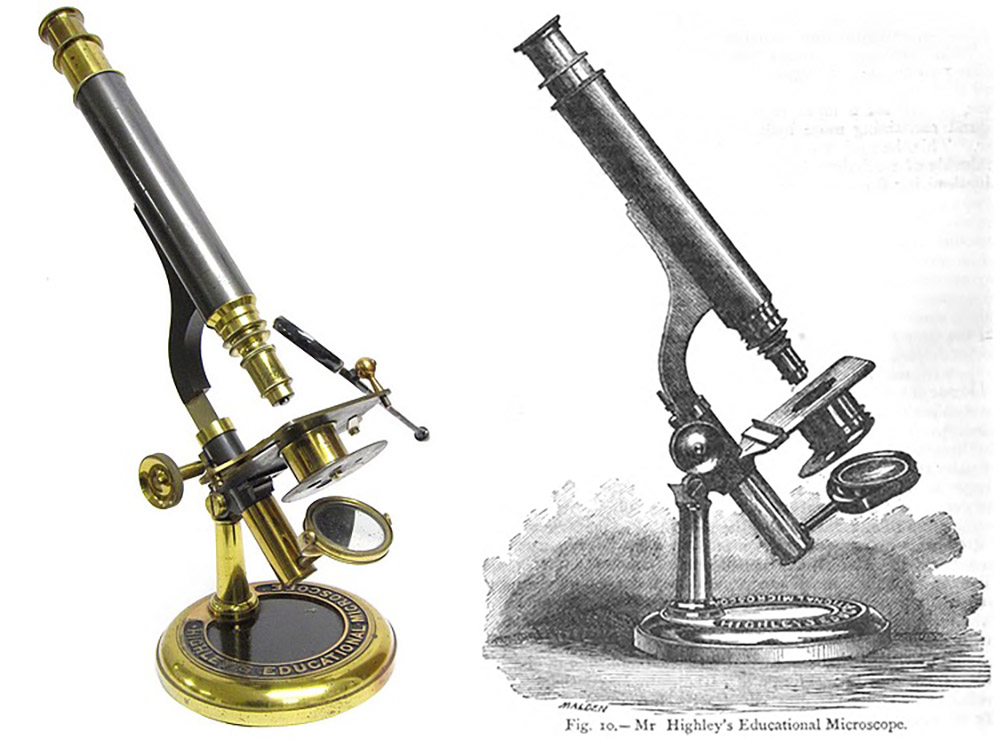
Figure 3.
Highley’s “Educational” microscope, ca. early/mid-1860s. The engraving is from “The British Medical Journal”, 1867. The pictures of the surviving microscopes are from the author's collection or adapted with permission from http://www.antique-microscopes.com/photos/higley.htm.
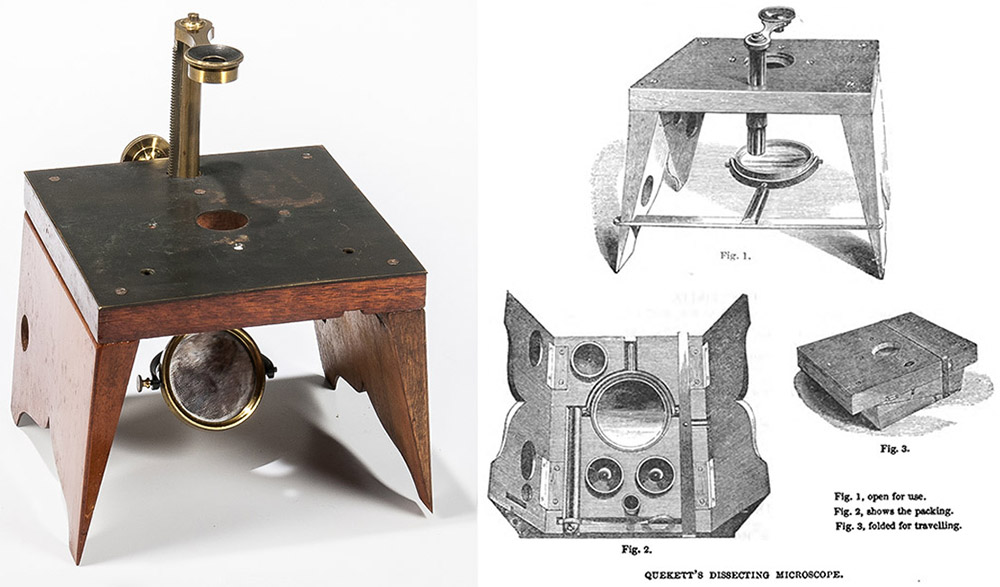
Figure 4.
Highley's “Large” microscope, with engraving from the catalogue of the 1862 International Exhibition of London (see Figure 8). The photograph is adapted for nonprofit, educational purposes from an internet auction site.

Figure 5A.
An early version of “Quekett’s Dissecting” microscope as manufactured by Samuel Highley, ca. 1855. The engravings are from Gorham’s “Unfrequented Paths in Optics, Part 1”. The photograph is adapted for nonprofit, educational purposes from an internet auction site.
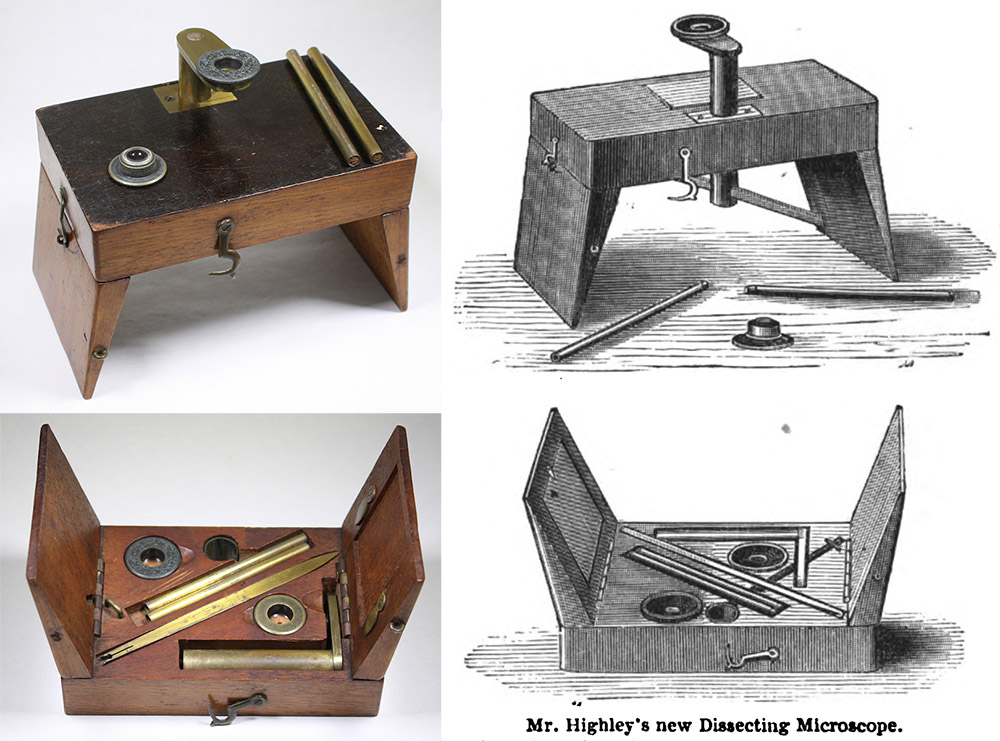
Figure 5B.
A later, ca. 1865, version of “Quekett’s Dissecting” microscope. It was intended for use with opaque specimens, as there is no provision for light to be directed upward through the specimen. The engravings are from “The Popular Science Review”, 1865. The magazine’s description: “Mr. Highley has just devised a form of dissecting microscope for the use of amateurs and beginners, which bids fair to become popular. It is somewhat upon the principle of the late Professor Quekett's instrument (which was itself planned by Mr. Highley), and consists of a mahogany stand, supported by lateral folding props, bearing a vertical limb of brass, with a horizontal projection to which the lenses are fixed. The vertical limb, instead of being moved by rack and pinion as in the more expensive apparatus, is elevated and depressed by a simple lever which works beneath the stage, and gives an easy sliding movement to the piece. The lenses are two in number, and are of average focus and denning power. When placed in its case the entire instrument may be conveniently carried in an ordinary sized pocket. It is sold at the moderate price of 12s. 6d., and was, we understand, devised to meet the requirements of one of our large public schools, in which botany is, in future, to be a branch of education.
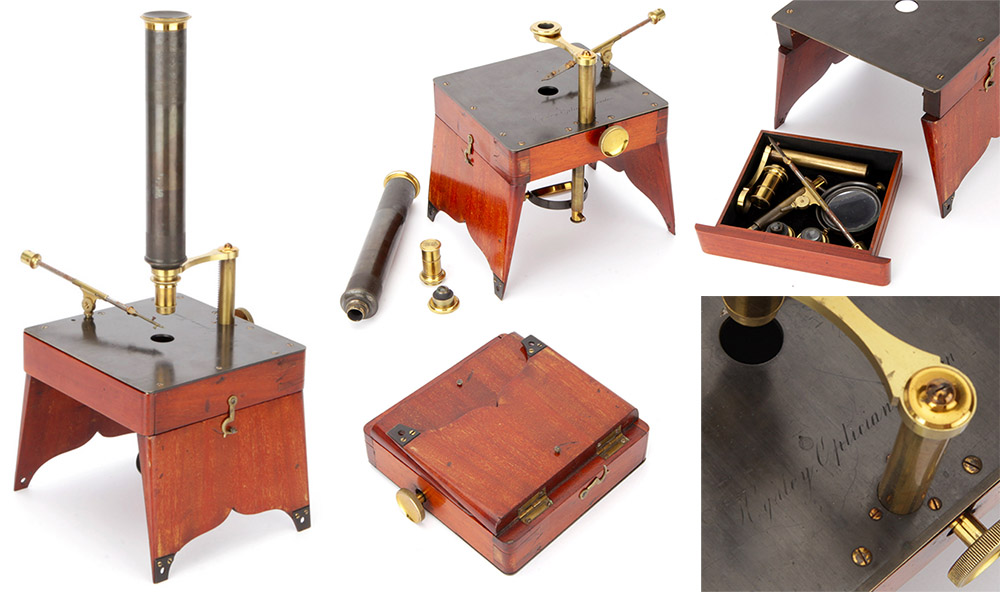
Figure 6.
Another version of “Quekett’s Dissecting” microscope, signed on the stage by Samuel Highley. A drawer for accessories fits under the stage, and is removed during use to permit light to be reflected up through the hole in the metal stage. It can be used as either a simple or compound microscope. A description of this instrument was not found during searches of Highley’s records. It probably dates from ca. 1870. Images adapted for nonprofit, educational purposes from an internet auction site and from http://www.fleaglass.com/ads/a-rare-quekett-dissecting-microscope-outfit-signed-highley-london.
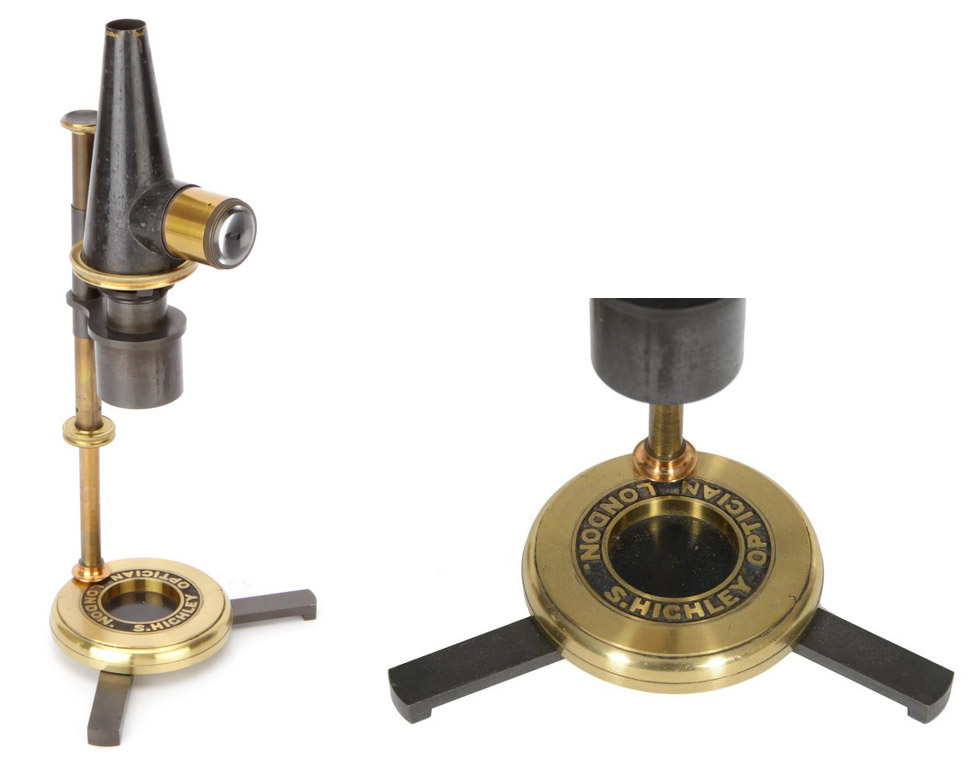
Figure 7.
A ca. 1870 microscope lamp by Highley. Images adapted for nonprofit, educational purposes from an internet auction site and from http://www.fleaglass.com/ads/a-rare-quekett-dissecting-microscope-outfit-signed-highley-london.
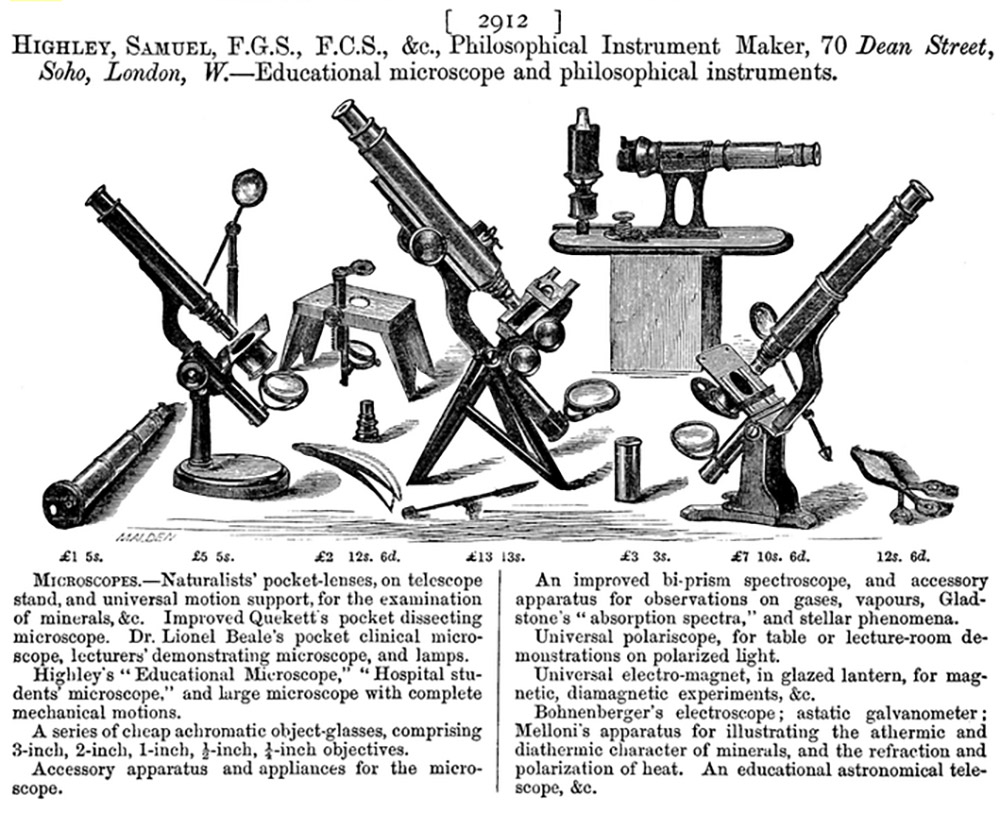
Figure 8.
An illustration and descriptions of Highley instruments that were exhibited in the 1862 London International Exhibition.
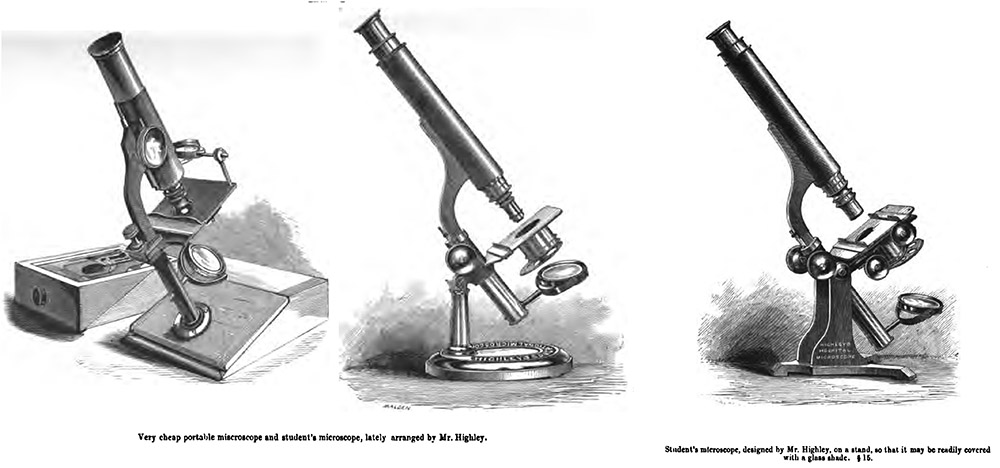
Figure 9.
Additional microscopes by Highley, from the 1865 (3rd) edition of Lionel Beale’s "How to Work with the Microscope".
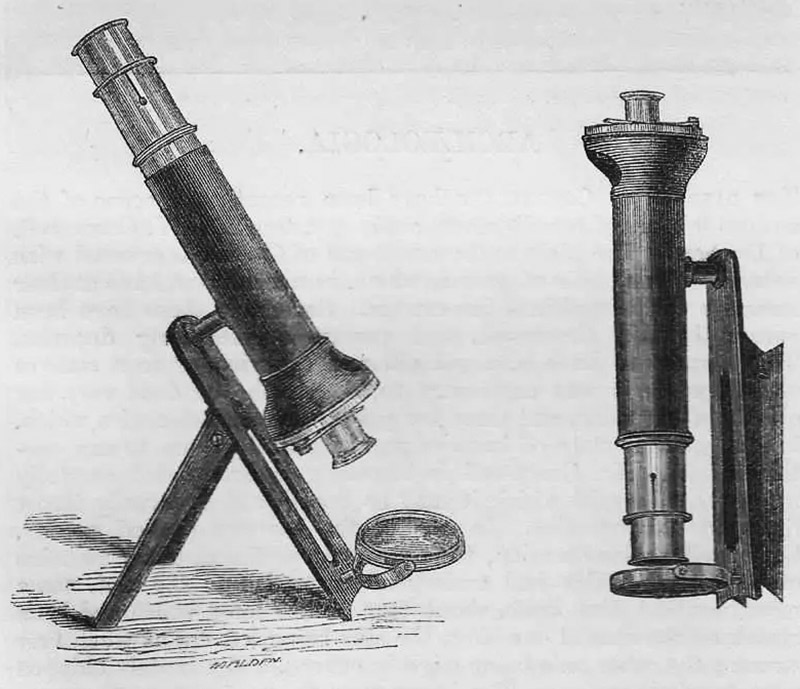
Figure 10A.
Highley’s “Pocket Stand” microscope, 1866. It was described in “The Intellectual Oserver": "At the last soirée of the Microscopical Society, Mr. Highley exhibited a new form of pocket microscope, which will meet the requirements of searchers for diatoms and other minute objects, and also those of medical men wishing for a portable instrument for the examination of morbid deposits. The annexed cuts show this instrument ... in two positions. In the one it is folded up, and in the other the stand is unfolded, and the mirror brought into its right position with reference to the stage. It packs into a case seven inches long, two and a quarter wide, and two and a half deep, thus occupying no more room than a small pocket telescope. The stand being of metal, and attached to the instrument, is neater and steadier than some of the wooden stands previously introduced, and the stage, which is arranged with universal motions, will carry a small live box, or an ordinary slide. When intended for medical use, it is accompanied by a very small pocket case, containing a test-tube and holder, spirit lamp, drop bottle, and test papers, while field naturalists are supplied with another "waistcoat-pocket case," as Mr. Highley terms it, a pipette, spoon, forceps, and corked collecting tubes. They can also have a hook-handled walking-stick, into the end of which screws a net, a bottle, or a hooked knife, and they are thus supplied with all the appliances needed for pursuing their search for microscopic objects. It is the neatest and most convenient thing of the kind we have seen, and can be made to work very well with 4-inch objective."
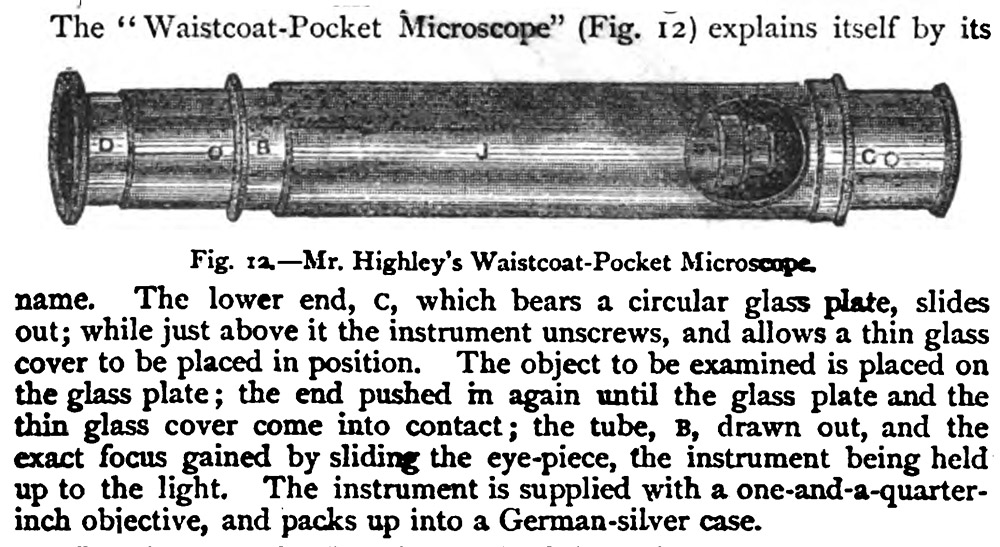
Figure 10B.
Highley’s “Waistcoat-Pocket” microscope, from “The British Medical Journal”, 1867.
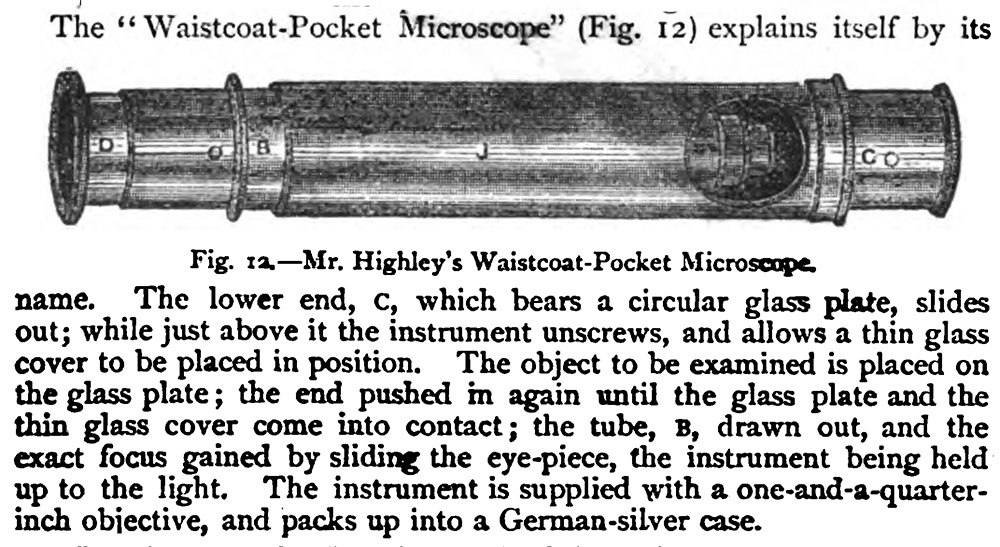
Figure 11.
1868 illustrations of Highley’s folding-stand “Field” microscope, kit of naturalist’s field supplies, and “Reflecting Live Cage”. The latter was described as consisting, “of a plate of brass having an aperture into which a piece of thin glass is cemented, fitting by spring sides on to a rectangular prism, so as to permit varying degrees of pressure upon an object, or drop of water placed between the two glass surfaces. The top surface of the prism being held horizontally, or nearly so, light is projected from the reflecting plane of the prism through the object to the eye; Mr. Highley has adopted for this arrangement a form of lens giving a. larger field of view in relation to the magnifying power than the ordinary Coddington lens”. From the 1868 (4th) edition of Lionel Smith Beale’s “How to Work with the Microscope”,.
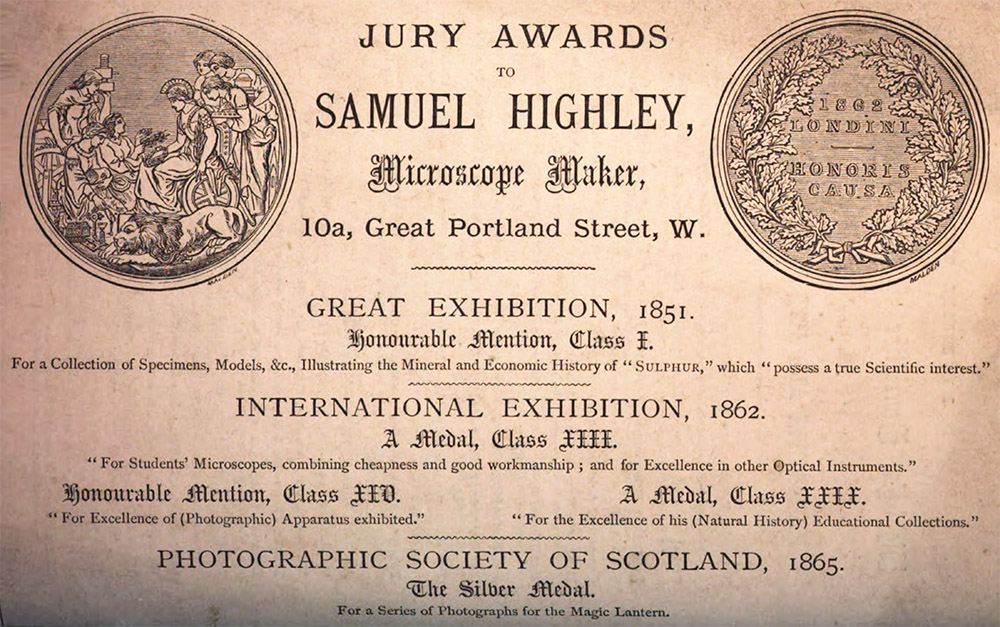
Figure 12.
An 1869 advertisement, noting awards won by Highley for his microscopes. From Highley’s booklet, “Reade's Prism for Microscope Illumination”.
Samuel Highley was born on February 12, 1826, son of Samuel Sr. and Ann Highley. The family lived at 174 Fleet Street, London, which was also Samuel Sr.’s shop that specialized in medical books.
A good view of Samuel’s upbringing and early career is presented in his father’s 1857 obituary: “It is with much regret that we announce the death of Mr. Samuel John Highley, senior, for many years Medical Publisher in Fleet-street, and Webb-street, Borough. From to 1803, the family were associated with the late Mr. John Murray, at 32, Fleet-street, in which house the first number of ‘The Quarterly Review’ was published. In 1803, the partnership was dissolved, and Mr. Highley's father removed to 24, and afterwards to 174, Fleet-street. In 1831, Mr. J. Highley purchased the business at 32, Fleet-street, on the bankruptcy of Messrs. Underwood, who had succeeded Mr. Murray on his removal to Albemarle-street, in 1812. Mr. Highley was known to the older members of the Medical Profession as a man of great energy and integrity; but within the last few years symptoms of softening of the brain presented themselves. He passed into a hypochondriacal state, and he almost systematically declined the offers of authors, labouring under an impression that no speculation would succeed. A few years later his son, who had not been brought up to the business, but had devoted himself to scientific pursuits, was called upon to take its management. He started ‘The Quarterly Journal of Microscopical Science’ and ‘The Library of Science and Art’. This latter undertaking promised works of considerable value, but not proving so remunerative as he anticipated, he relinquished the business, and Mr. Churchill became its purchaser. Mr. Highley, senior, died on October 22, from gradual paralytic decay, after a lengthened period of suffering, and was buried at Brompton Cemetery on the Thursday following”.
Highley continued to publish scientific and medical books and journals for several years after his father’s death. Among these were Transactions of the Microscopical Society of London, Lionel Smith Beale’s The Microscope: its Application to Clinical Medicine, Thomas Huxley’s The Microscope: in its Special Application to Animal Anatomy and Physiology, and Hermann Schacht’s The Microscope: in its Special Application to Vegetable Anatomy and Physiology.
Prior to his father’s death, the two men operated as Highley and Son, operating from 32 Fleet Street. An 1851 catalogue contains 64 pages of book titles available from the business, with about 35-40 titles per page (Figure 13). Some 35 journals and dozens of anatomical charts were also available.
Samuel presented three exhibits at the 1851 London Exhibition: “Native sulphur, from Sicily, with products” and “Rocks and fossils, to illustrate works on geology”, under his own name, and “Anatomical statuette, exhibiting the external muscles, with outline, drawings, &c.” as “Highley S.” To judge from his later memberships in both the Chemical and Geological Societies, the first two displays were probably items of his own interest, while the third was a sample from the Highley and Son shop.
An 1853 advertisement indicates that Samuel had a somewhat independent business, S. Highley, Junior, which focused on microscopy, geology, and chemistry (Figure 14). By November of that year, the business(es) were rebranded as “Highley’s Scientific Library” or "Scientific Library” (Figure 15). The shop was then selling the “Hospital” microscope, lenses (imports, according to Beale), camera set-ups for microscope use, and Samuel Highley’s newly-invented achromatic gas microscope lamp (Figures 15 and 16).
Highley demonstrated his microscope lamp to the Microscopical Society of London during 1853, and his report was published in the Society’s Transactions. Highley does not appear to have joined the Society, but his role as their publisher evidently afforded him free access to the members. Also in 1853, he presented on his new form of microscope camera, and in 1854, he attended a meeting where glass ampules were discussed (and described to the attendees a form of ampule that he was currently selling) and spoke on “Is coal a mineral species?”.
Highley served as Secretary of the Photographic Society of Great Britain in the 1857. He was an assistant editor of The British Journal of Photography, and edited The British Journal Photographic Almanac in 1861 and 1862. He wrote numerous articles on photography during his life.
Samuel married in 1858, to Sarah Titchener. They had at least nine children together, with the last-known baby born when Sarah was 42 years old.
Around the time of his father’s death and his marriage to Sarah, Samuel moved the business and family home to 70 Dean Street, Soho.
A large number of different microscopes and apparatus were exhibited by Samuel at the 1862 London International Exhibition. Highley won a Medal for “Students microscopes, combining cheapness and good workmanship, and for excellence in other optical instruments”, and a Medal and an Honourable Mention for his educational and photographic displays (Figures 18 and 19).
Another move occurred during the late summer of 1863, to 18 Green Street, Leicester Square (Figure 21). It is not clear what, if any, apparatus were manufactured on-site, or if items were produced off-site on contract. Considering Highley’s lack of formal training in glass, brass, or wood, it is likely that he did not physically produce apparatus himself.
In addition to retail, Highley offered classes at his shop. This advertisement ran in The Chemical News in 1863, “Mr. S. Highley, F.G.S., F.C.S., &c.—Scientific Educational Museum, 18, Green Street, Leicester Square, gives evening class instruction in the following educational courses: Geology, Mineralogy, chemical and physical. Photography: its principles, practice, and applications, &c., &c.”
A skilled photographer and lanternist, Highley was an early advocate for the use of projection lanterns as educational tools. His papers on “The application of photography to the magic lantern educationally considered” (1863) and “On the application of photography and the magic lantern to class demonstrations in microscopic science and natural history” (1864), were widely quoted for many years afterward.
Associated with that, Highley invented a “lantern polariscope” in 1864. It is pictured in Figure 22, below, and described as “an arrangement that has long been a desideratum with those who delight in popularising science - namely, a polariscope that could be used in conjunction with the numberless magic lanterns that are now scattered over the kingdom and our colonies, without entailing the risk and trouble of sending them to the optician ‘to be fitted’ with such an adjunct, and at a cost that is within the means of most persons who indulge in such pursuits. . . By this simplification of parts, Mr. Highley is enabled to supply an instrument - which for practical purposes can hardly be surpassed for efficiency - at one-half the price at which the gas polariscopes hitherto constructed have been sold. We fancy that many will appreciate this attempt to bring a costly instrument within the reach of experimentalists”.
Highley joined the Quekett Microscopical Club on June 14, 1865.
Although he was a pioneering supplier of inexpensive, high-quality microscopes to the working classes, Highley had since been joined by many other manufacturers who targeted that market. In financial straits, Highley filed for bankruptcy protection on October 12, 1865. He evidently resolved those debts, and remained in business. A second bankruptcy filing was made on February 14, 1868. Those debts probably led to the apparent demise of the Highley business a few years afterward.
A final business move took place during 1869, to 10A Great Portland Street (Figure 24).
Continuing to look for an innovative edge, Highley produced and marketed “Read’s Prism for Microscopic Illumination” (Figure 26). This device mounted to a microscope’s substage, and could direct light upward to specimens at variable angles. This was of great use to diatomists who were continually searching for better ways to observe fine details of their subjects.
Highley’s entries in the 1871 London International Exhibition focused on projection lanterns and photography: “6795, Educational Magic Lantern. For teaching geography and science in schools; with protective slide tray”; “6796 Educational photographs. For the magic lantern; for class demonstrations”; and “6797 Model of a new system of lecture demonstration by means of the magic lantern”.
I have not located any reference to Highley having a shop after 1870, suggesting that he let the business go after the bankruptcies. His wife, Sarah, died in 1876. The 1881 census listed Highley as living alone, at 21 Francis Street, Totenham Court. The absence of any of his children is remarkable, as it was customary for a widowed parent to live with at least one of his children. His youngest were in Berkshire, presumably with relatives of Sarah, and the others were dispersed.
Publications on Highley after the early 1870s are those of a hobbyist. He wrote an article for The Fishing Gazette in 1877 on “Sensitiveness of fish”, and a booklet entitled Where to Fish Round London in 1882. A book, Photography for Amateurs, was published in 1884, and a second edition in 1886. A review stated that, “This is a good book, written by one who has had experience in teaching. Samuel Highley is a veteran photographer, formerly well known both as a dealer in apparatus and as a writer and lecturer”. None of those books/booklets was published by Highley.
He wrote a letter to The Photographic News in 1885, proposing that someone construct a museum of early photography. He concluded that letter by indicating that he had access to early photographs by Thomas Wedgwood (1771-1805).
By 1891, Highley had settled in to Sutton’s Hospital at the Charterhouse, a retirement community. That year’s census recorded him as being a “Scientific Author Editor Journalist &c.”
Highley continued to write and publish. For example, in 1892, he wrote an article on “Transparent films and roller slides past and present”.
Samuel Highley died during late 1900.
The British Journal of Photography noted Highley’s passing in the January 4, 1901 issue: “The old century did not expire without carrying with it one who was identified with photography and its journalism in their comparatively early days. Mr. Samuel Highley, F.C.S., who died recently, had long since passed out of the sight and mind of the photographic world, but nearly forty years ago he was an assistant-editor of this Journal, and on the title-page of the Almanac for 1861, a tiny little volume which one could carry in the waistcoat pocket without courting the smallest discomfort, his name appears as the Editor. He interested himself in popularising optical projection for scientific purposes, and some of his articles on the subject, written at about the date mentioned, are so admirably expressed that, if reprinted now. they would pass muster as the work of a modern author newly emphasising the value and advantages of the lantern in the lecture room. A full list of Mr. Highley's public contributions to general scientific knowledge lies before us in the form of a printed pamphlet. Besides photography, mineralogy and microscopy appear to have been amongst his subjects. He was a prolific writer and a man of varied tastes and occupations. The late Mr. Highley's old friend and confrére, George Dawson, also ended his days in the Charterhouse, into which haven of rest, so sympathetically described by Thackeray in ‘The Newcomes’, both were assisted by those associated in more recent times with the conduct of the Journal. Right to the last it was pleasing to note that both gentlemen retained a kindly thought for The British Journal of Photography, which had helped them up to their successes, and did not turn away from them in time of need. Mr. Highley who was in his 75th year. was Secretary of the Photographic Society of Great Britain in the year 1857, and in his time held many other scientific and journalistic offices. He passed a varied, busy, and useful life, and his record, if unfamiliar to the present generation of scientific journalists, was as creditable as it was full”.
The Bookseller published a brief obituary, “Recently - At the Charterhouse, Dr. Samuel Highley, formerly a publisher and scientific writer. He was, it is stated, the first to place on the market a cheap and effective microscope for the use of students, and helped to popularise the magic lantern in the illustration of lectures”.
A colleague, writing under the nom de plume “An Old Lanternist”, gave a personal farewell, “I saw by a short paragraph in one of the daily papers that an old friend of mine, and one of the earliest workers in the optical lantern, has passed away. I refer to Samuel Highley. It was he who took up the lantern in earnest with a desire to improve it in design and arrange the working parts and accessory apparatus for convenience of manipulation. . . If my late friend had only been as ready in money-making as he was with his pen and tongue, he should have made, if not a fortune, at least a respectable income. As it was, he was elected to the Brotherhood of the Charterhouse, at which institution he ended his days in comfort. I saw him a few months since after a stroke of paralysis, and, although moderately well and mentally active, he would every now and then lose the thread of his remarks or forget what a few minutes before he desired to tell one”.
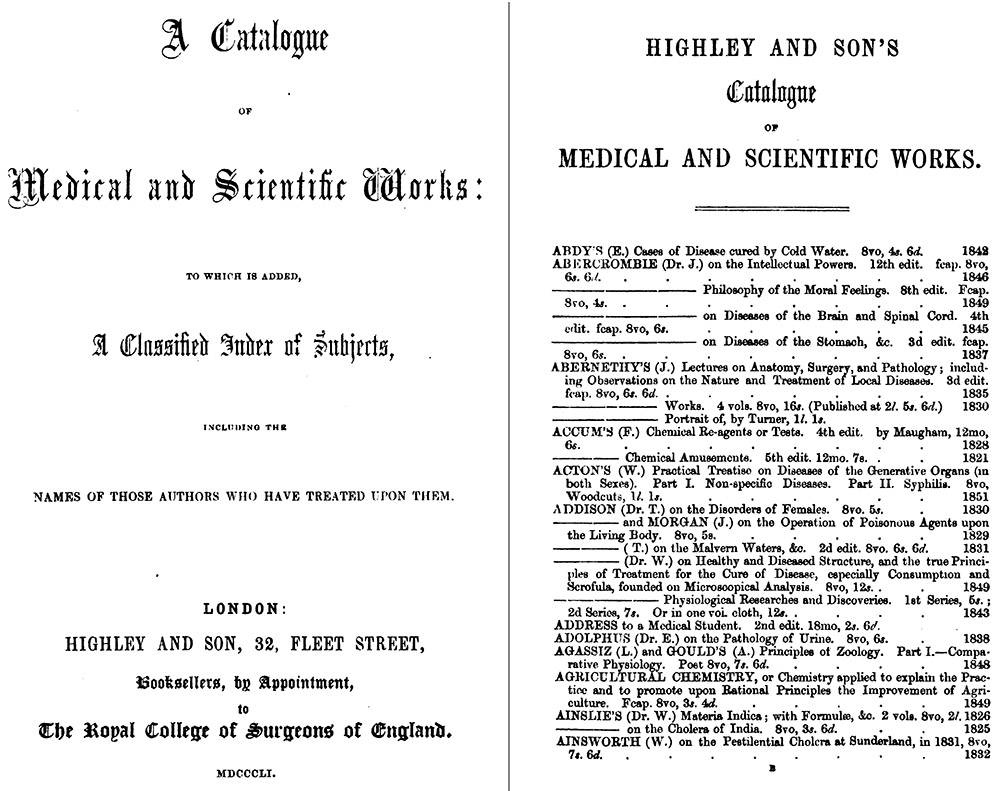
Figure 13.
Cover page and a representative internal page from Highley and Son’s 1851 Catalogue of Medical and Scientific Works.
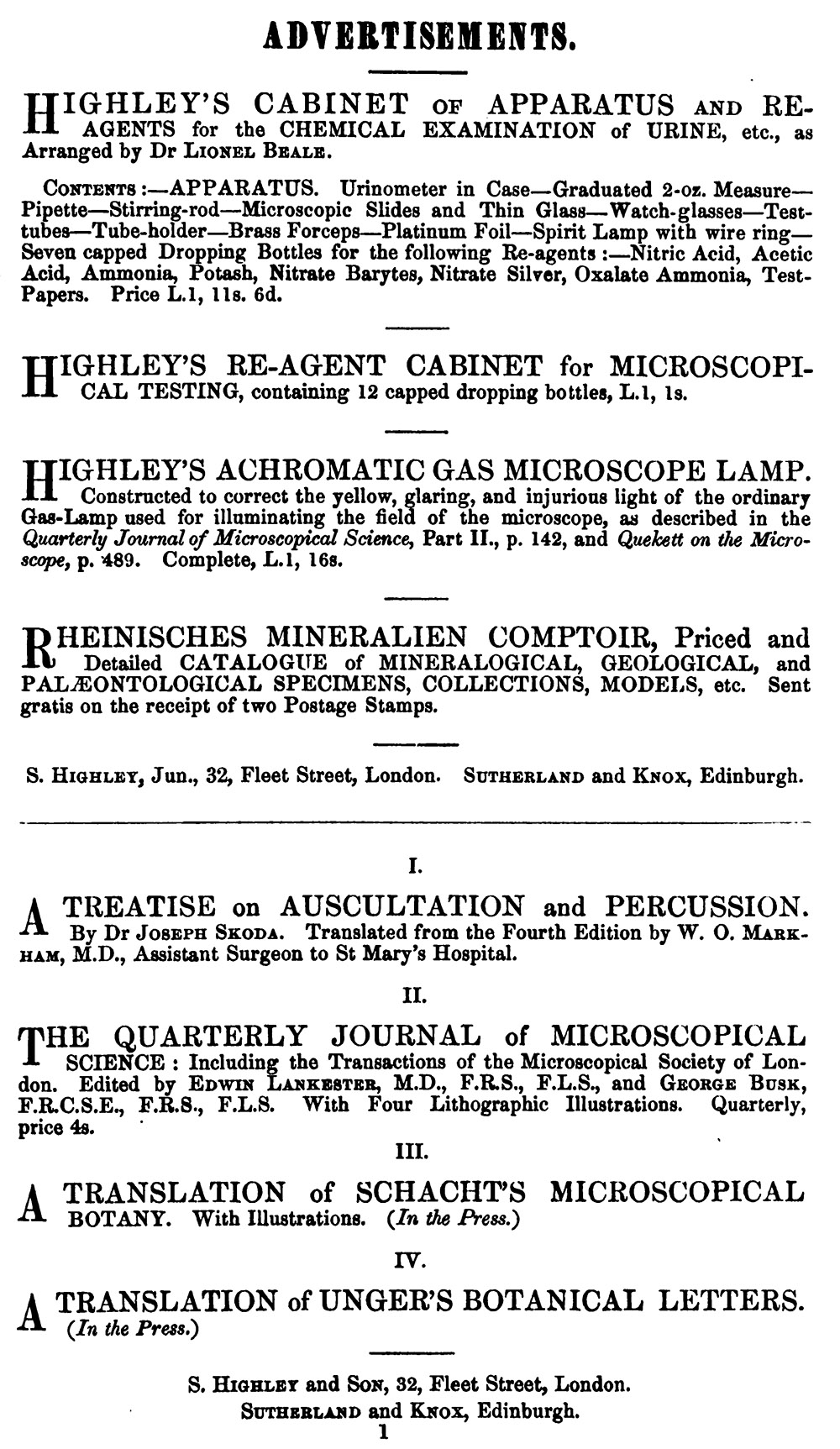
Figure 14.
A page of 1853 advertisements, with microscopical, chemical, and geological items from “S. Highley, Jun.”, and scientific and medical books/journals from “S. Highley and Son”. From Hannover and Goodsir’s “On the Construction and Use of the Microscope”.

Figure 15.
1853 advertisements for Highley’s first microscope, the “Hospital”, and microscopical apparatus (see Figure 1). Note that the business was now called “Highley’s Scientific Library”. From the November 12, 1853 issue of “The Literary Gazette” (originally printed as a single column, the full length of a page).
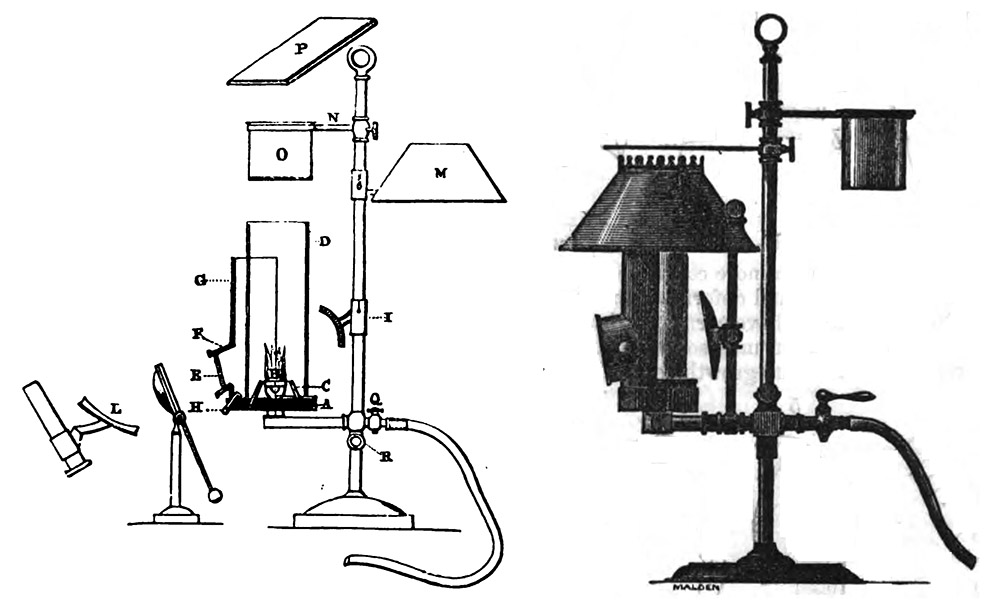
Figure 16.
Illustrations of Samuel Highley’s first major invention for the microscope: an achromatic gas lamp. Left, from his 1853 presentation to the Microscopical Society of London. Right, from an 1867 advertisement that appeared in “Hardwicke's Bibliographical and General Index to Current Literature”.
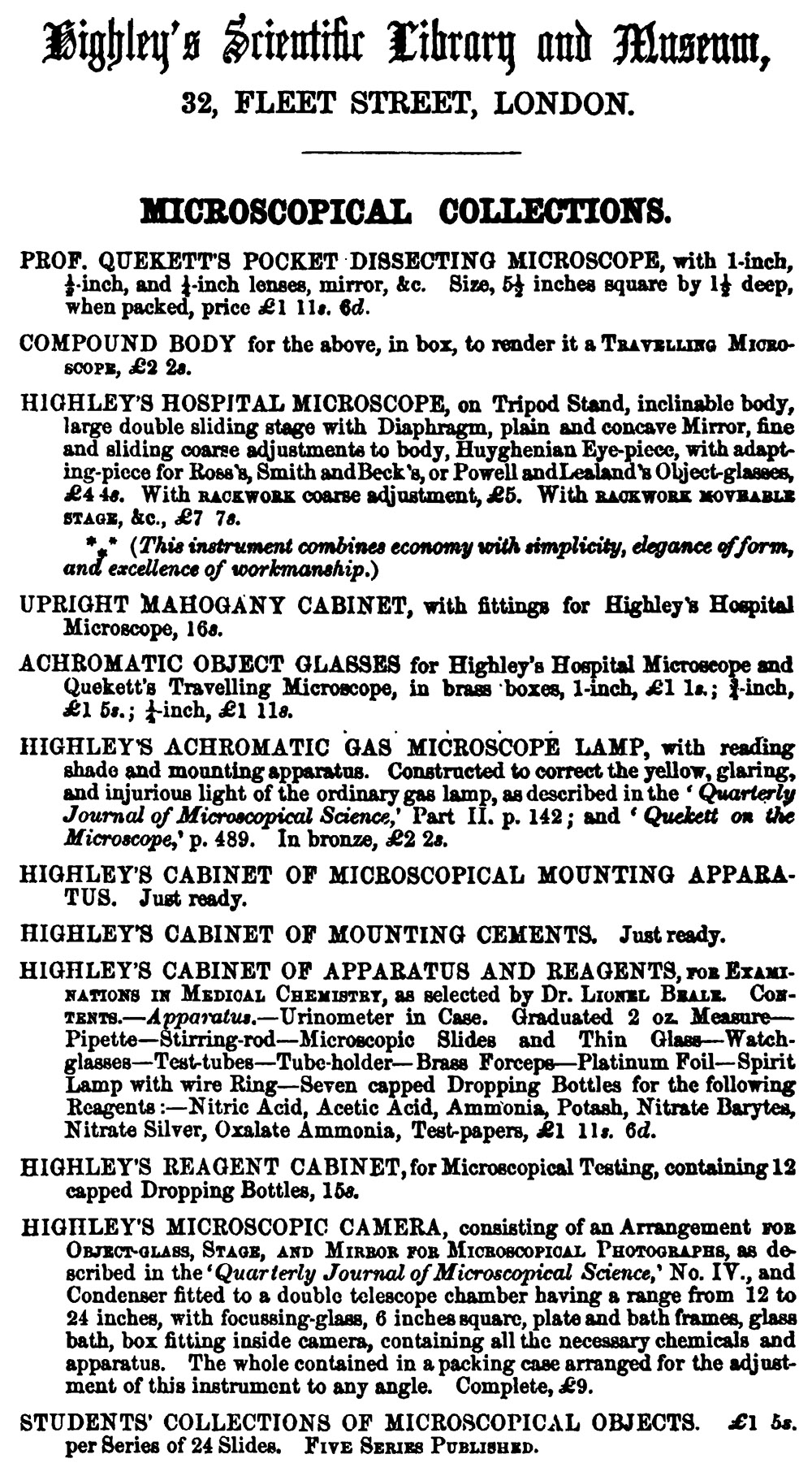
Figure 17.
Advertisement from John Quekett’s 1855, third edition of “A Practical Treatise on the Use of the Microscope”. By this time, Highly had added “Quekett’s Dissecting Microscope” to his inventory (see Figure 4).
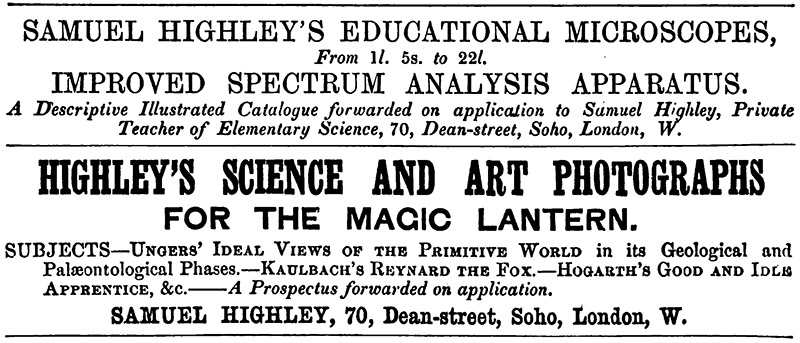
Figure 18.
January, 1862 advertisements, from “The Cornhill Magazine”. Highley moved his shop from 32 Fleet Street to 70 Dean Street ca. 1858.
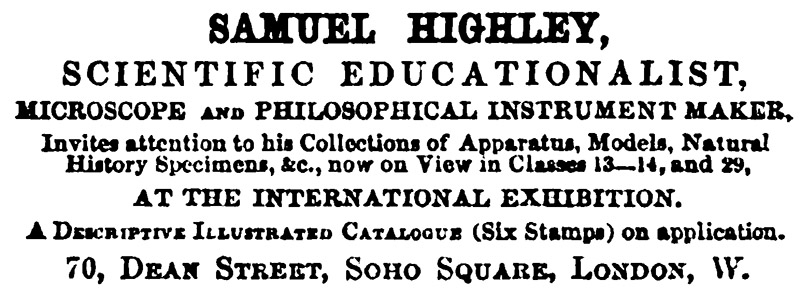
Figure 19.
June 28, 1862 advertisement, during that year’s International Exhibition. From “Notes & Queries”.
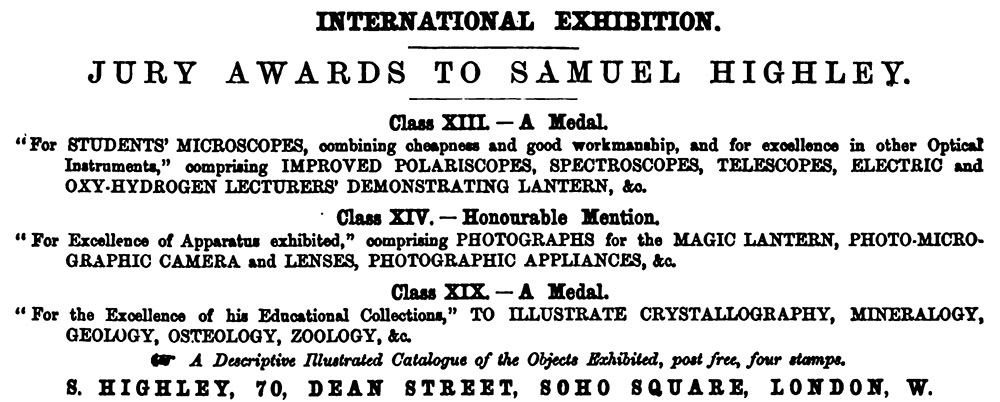
Figure 20.
September 20, 1862 advertisement, touting Highley’s three awards from that summer’s International Exhibition. From “The Lancet”.
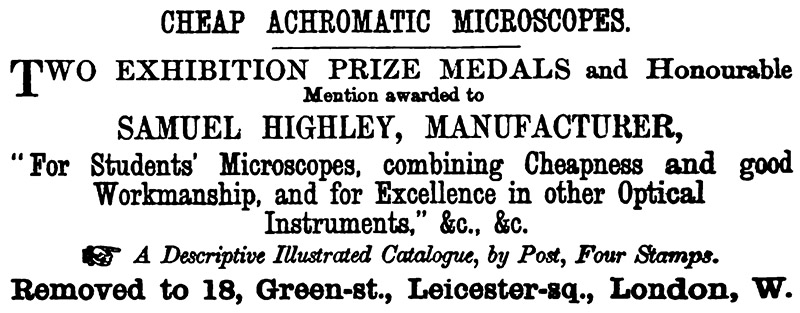
Figure 21.
The shop and family home moved to 18 Green Street during late summer, 1863. From “The Dublin Quarterly Journal Medical Science”.
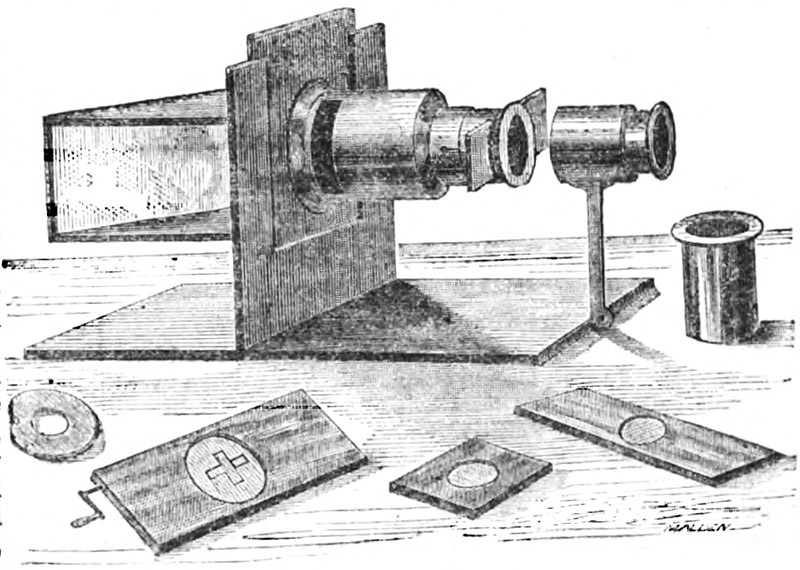
Figure 22.
Samuel Highley’s 1864 invention, a lantern polariscope. From :The Chemical News”: “The various parts are mounted on what the inventor calls a ‘gout-board support’. The upright is fitted with an adjustable panel, that carries a bundle of glass plates on one side, and the stage and power on the other. This allows of the entire arrangement being accurately ‘centred’ with any lantern with which it may be employed. When adjusted, the panel is clamped by means of a milled-head screw. The ‘bundle’ consists of such a number of thin glass plates as will give a bright reflected beam of polarised light, and is attached to the panel at the proper angle for producing such a beam. The spring stage for carrying selenite designs, unannealed glasses, pressure and heating clamps, and the larger objects, is formed within a large tube attached to the front side of the panel; and to the front of this is screwed a spring jacket, within which slides the power and stage for the smaller crystals employed. To the front part of the base-board an adjustable rod is fixed that carries the analyser, which consists of a large prism, made expressly for the purpose of giving a large and pure field of colour, the absolute field attainable being, of course, dependent on the intensity of the source of light employed, as oil, oxy-calcium, oxy-hydrogen, or the electric. Provision is made for rotating both the smaller and larger objects, when necessary for the demonstration of certain phenomena. When selenite designs are shown on the screen, the crystal power is replaced with another of suitable construction. To use this polariscope, the nozzle is placed at right angles to the screen, and the base-board is then clamped to the table. The front lenses of the magic lantern are removed, the condensers only being employed, and the source of light moved till a beam of parallel rays is produced. The lantern nozzle is then pointed at the bundle till the rays are incident at the polarising angle for glass, the proper direction being indicated for the uninitiated by a white line marked on the framework, the right adjustment of parts being further indicated by the appearance of an even disc of light upon the screen. A design is then inserted in the large stage, its lines of construction focussed, the analysing prism inserted in its jacket, and the coloured effect produced and varied either by the rotation of the prism or the rotation of the design or crystal. By removing the panel from the support, and placing it before a window with nozzle pointing upwards, and adding a suitable power, it may be then used as a table polariscope, or the light of a reading-lamp may be employed as the source of light. By this simplification of parts, Mr. Highley is enabled to supply an instrument - which for practical purposes can hardly be surpassed for efficiency - at one-half the price at which the gas polariscopes hitherto constructed have been sold. We fancy that many will appreciate this attempt to bring a costly instrument within the reach of experimentalists”.
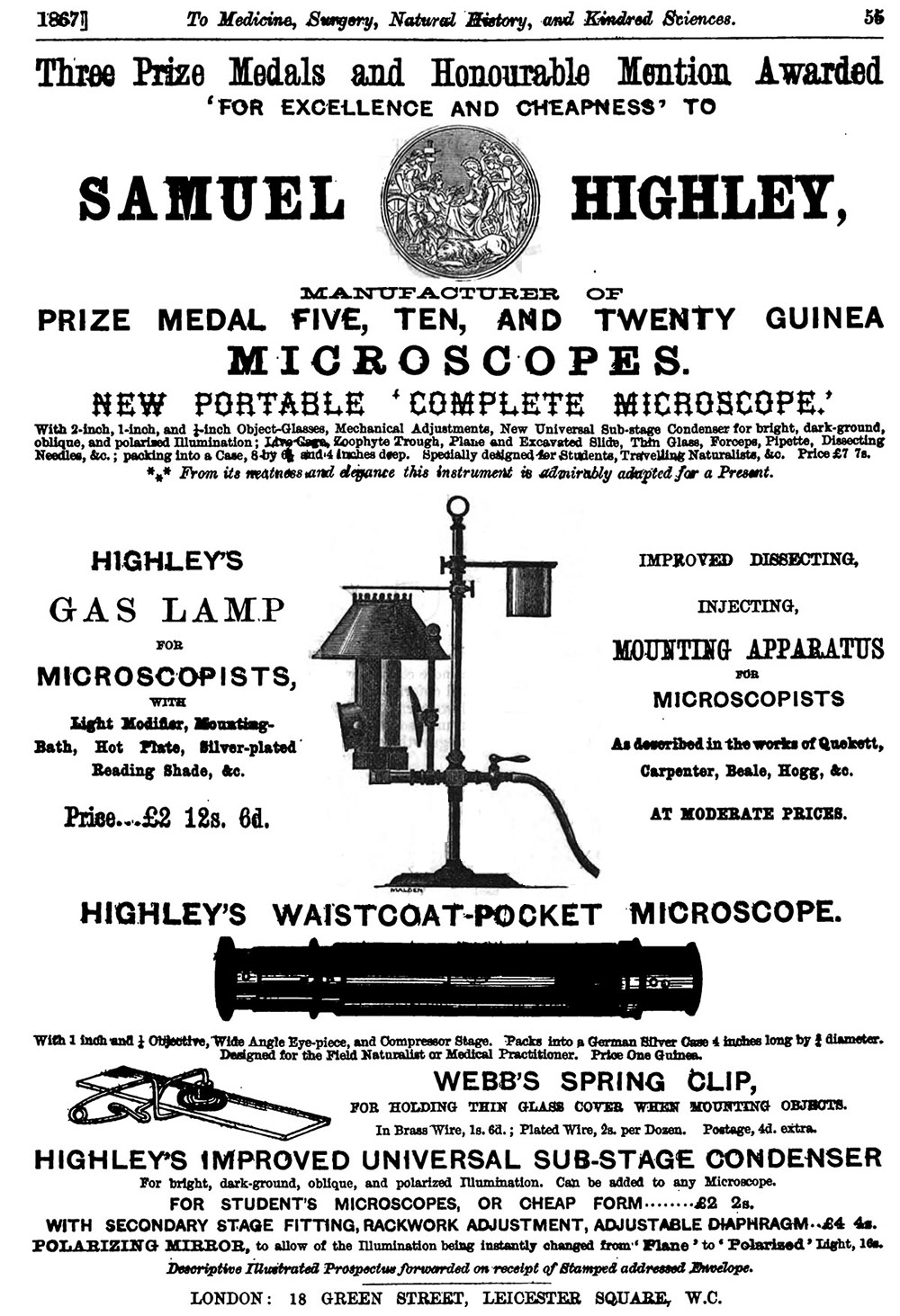
Figure 23.
An 1867 advertisement, from “Hardwicke's Bibliographical and General Index to Current Literature”.
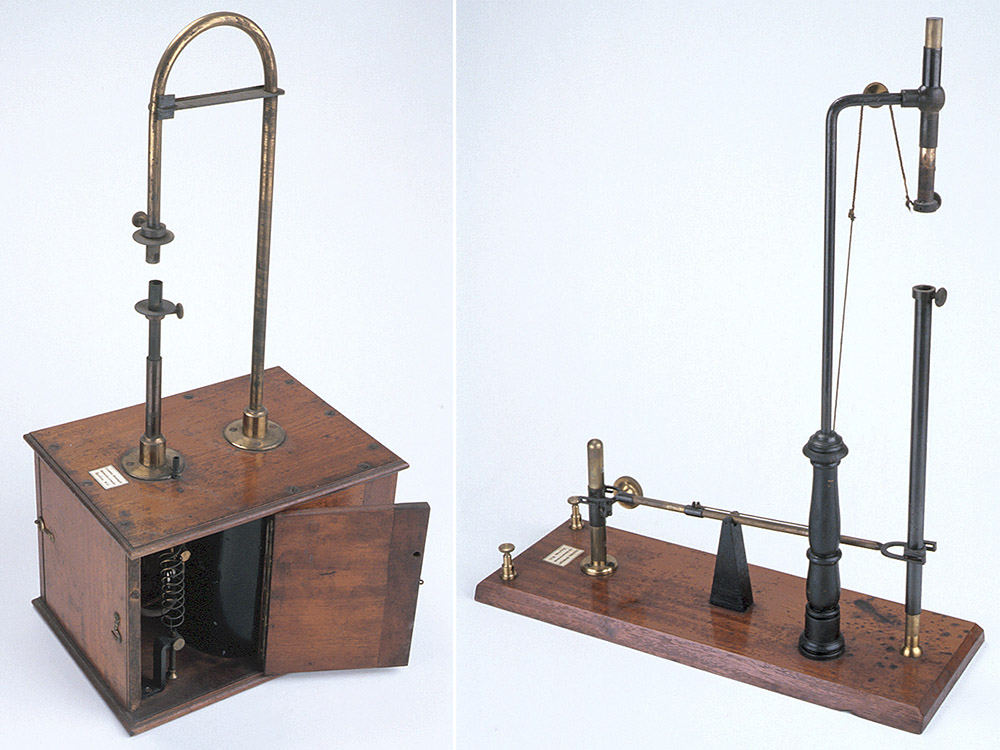
Figure 24.
Malden's solenoid / counterpoise arc light and manually regulated arc light, both signed Samuel Highley, 18 Green Street, dating their production to between 1863 and 1869. Adapted for nonprofit, educational purposes from https://www.mhs.ox.ac.uk/collections/imu-search-page/record-details/?thumbnails=on&irn=1598&TitInventoryNo=67209 and https://www.mhs.ox.ac.uk/collections/imu-search-page/record-details/?thumbnails=on&irn=1610&TitInventoryNo=69018.
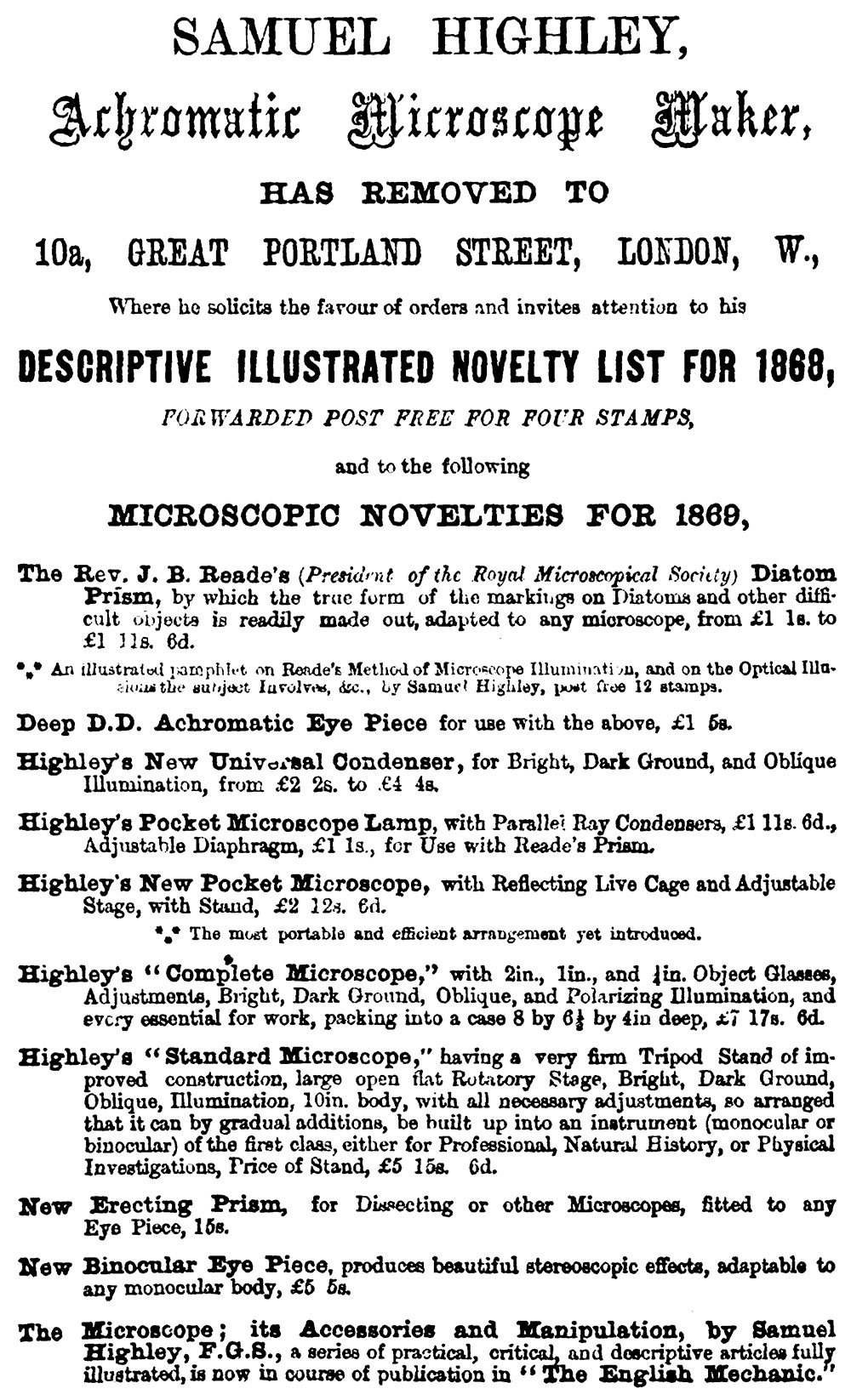
Figure 25.
An 1869 notice that Highley had recently moved to 10A Great Portland Street, and a partial list of microscopy items that he offered. From Highley’s pamphlet on Reade’s Prism.
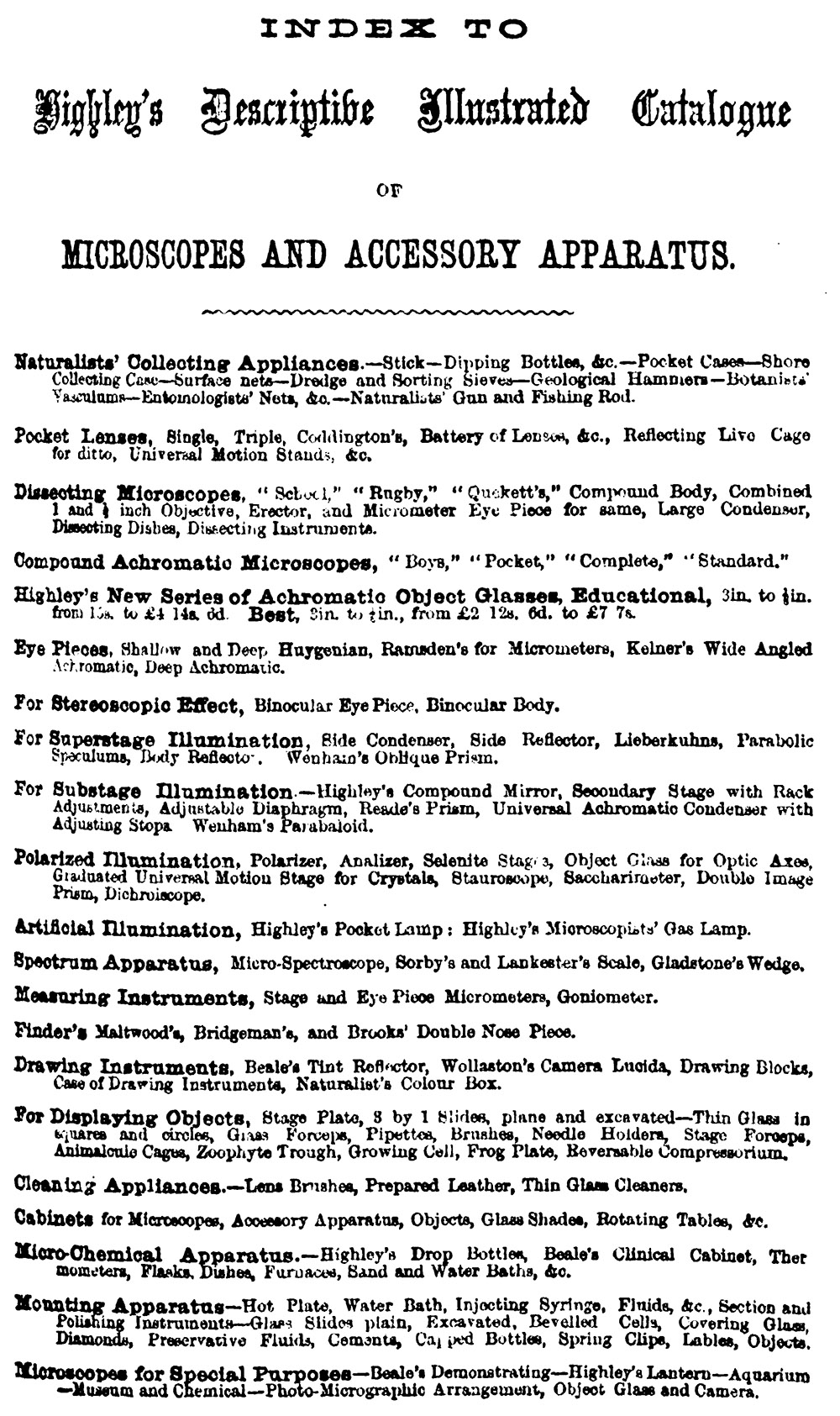
Figure 26.
Additional microscopy items offered by Samuel Highley in 1869. From his pamphlet on Reade’s Prism.
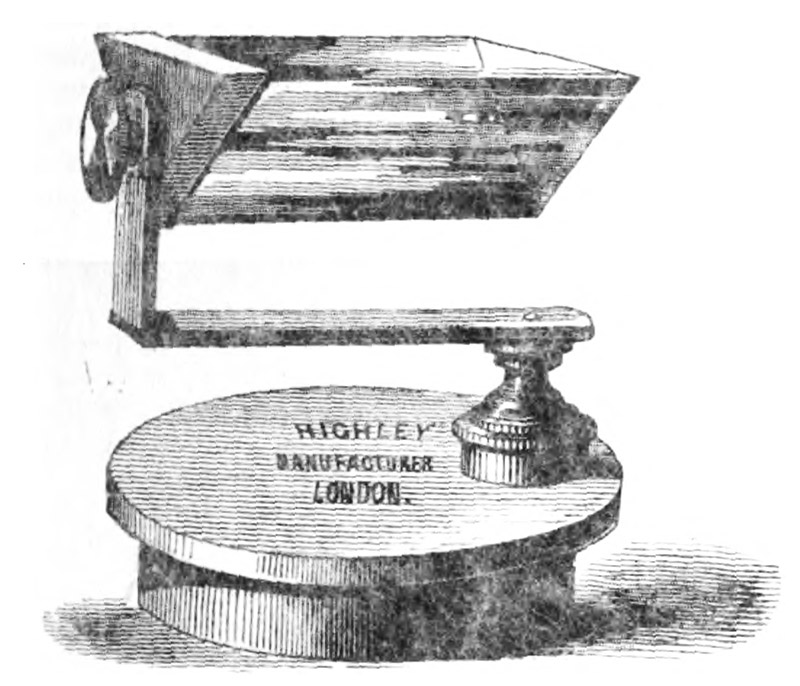
Figure 27.
An engraving of Reade’s Prism, manufactured by Samuel Highley, from his pamphlet on the object. A surviving Reade’s Prism is shown in Turner’s “Great Age of the Microscope” as item 353, on page 298.

Figure 28.
An 1870 advertisement, from “The Student and Intellectual Observer of Science, Literature, and Art”.
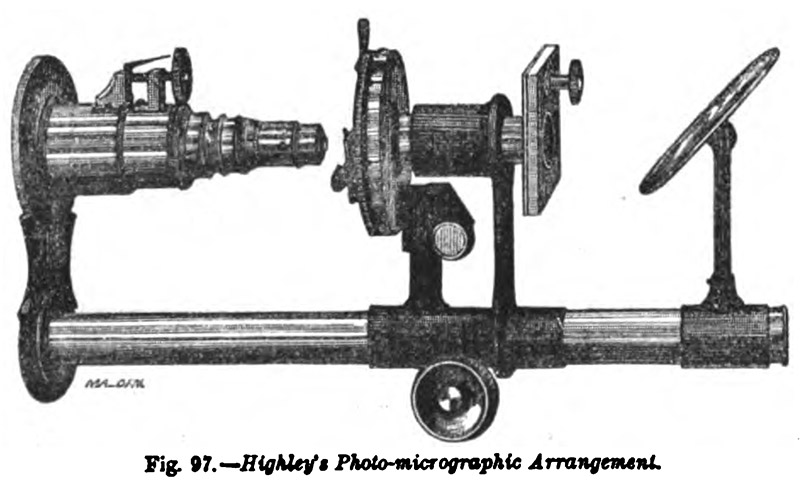
Figure 29.
Samuel Highley’s apparatus for photomicroscopy. From Hogg’s “The Microscope”, sixth edition, 1867.
Acknowledgements
Thank you to Allan Wissner for permission to use images from his collection, http://www.antique-microscopes.com.
Resources
Anthony's Photographic Bulletin (1887) Vol. 18, page 201
Beale, Lionel Smith (1854) The Microscope, and Its Application to Clinical Medicine, S. Highley, London
Beale, Lionel Smith (1857) How to Work With the Microscope, J. Churchill, London, page 10
Beale, Lionel Smith (1868) How to Work With the Microscope, fourth edition, J. Churchill, London, pages 146-148
The Bookseller (1901) Note on Samuel Highley’s death, Vol. 6, page 14
The British Journal of Photography (1901) The late Samuel Highley, Vol. 48, page 12
The British Medical Journal (1867) Report on modern microscopes and recent improvements in microscopical apparatus, Vol. 2, pages 346-347
The Chemical News (1863) Vol. 7, page 156
The Chemical News (1864) New lantern polariscope, Vol. 9, pages 77-78
Christening record of Samuel Highley (1826) Parish records of St. Dunstan in the West, accessed through ancestry.com
The Cornhill Magazine (1862) Advertisement from Samuel Highley, January issue
The Dublin Quarterly Journal of Medical Science (1863) Advertisement from Samuel Highley, Vol. 36, page 20
England census and other records, accessed through ancestry.com
Gorham, John (1855) Unfrequented Paths in Optics, Part 1: Light from a Pin-Hole, S. Highley, London
Hannavy, John (2013) Encyclopedia of Nineteenth-Century Photography, Routledge, New York, pages 215 and 656-657
Hannover, Adolph, and John Goodsir (1853) On the Construction and Use of the Microscope, Sutherland and Knox, Edinburgh
Hardwicke's Bibliographical and General Index to Current Literature (1867) Highley, Samuel, 18 Green Street, Leicester Square, W.C., pages 45-46
Hardwicke's Bibliographical and General Index to Current Literature (1867) Advertisement from Samuel Highley, page 55
Highley and Son (1851) A Catalogue of Medical and Scientific Works, London
Highley, Samuel (1853) Achromatic gas-lamp for the microscope, Transactions of the Microscopical Society of London, Vol. 1, pages 142-144
Highley, Samuel (1853) Microscope camera, Transactions of the Microscopical Society of London, Vol. 1, pages 305-306
Highley, Samuel (1854) Is coal a mineral species?, Transactions of the Microscopical Society of London, Vol. 2, page 141
Highley, Samuel (1855) Contributions to micro-mineralogy, Quarterly Journal of Microscopical Science, Vol. 4, pages 277-286
Highley, Samuel (1863) The application of photography to the magic lantern educationally considered', The Photographic News, Vol. 7, pages 104-105
Highley, Samuel (1865) The application of photography and the magic lantern to class demonstrations in microscopic science and natural history, Report of the Thirty-Fourth Meeting of the British Association for the Advancement of Science, page 98
Highley, Samuel (1869) Reade’s Prism for the Microscope, S. Highley, London
Highley, Samuel (1869) The microscope: its accessories and manipulation, The English Mechanic and Mirror of Science, Vol. 9, pages 144-146, 196-197, and 306-307, and Vol. 10, pages 8-10 and 32-33
Highley, Samuel (1877) Sensitiveness of fish, The Fishing Gazette, Vol. 1, page 8
Highley, Samuel (1878) How to employ photography and the lantern as educational aids�������������������������������������������������������������������������������������������, The British Journal of Photography, Vol. 25, page 922
Highley, Samuel (1882) Where to Fish Round London, David Bogue, London
Highley, Samuel (1886) Photography for Amateurs, Cassell & Co., London
Highley, Samuel (1885) Needed, a photographic library and museum, The Photographic News, Vol. 29, pages 668-669
Highley, Samuel (1892) Transparent films and roller slides of the past and present, The British Journal of Photography, pages 104-105
Hogg, Jabez (1869) The Microscope, pages 99-101, G. Routledge and Sons, London
The International Exhibition of 1862 (2014) Vol. 2, reprinted by Cambridge University Press, Cambridge
The Lancet (1862) Advertisement from S. Highley, September 20 issue
The Lancet (1863) Advertisement from S. Highley, September 19 issue
London Gazette(1865) Notice of Samuel Highley filing for bankruptcy, October 12
London Gazette(1868) Notice of Samuel Highley filing for bankruptcy, February 14
The Literary Gazette (1853) Advertisements from S. Highley, November 12 issue, page 1085
The Medical Times and Gazette (1857) Obituary of Samuel Highley, Sr., Vol. 2, pages 488-489
Notes and Queries (1862) Advertisements from Samuel Highley, advertiser sections, February 22 and June 28
Official Catalogue of the Great Exhibition of the Works of Industry of All Nations (1851) pages 22 and 152
Official Catalogue of the Industrial Department, London International Exhibition (1871) page 96
“An Old Lanternist” (1901) Occasional notes, The British Journal of Photography, Vol. 48, supplement, pages 3-4
The Popular Science Review (1865) Cheap form of dissecting microscope, Vol. 4, page 128
The Post Office Directory of Chemists and Druggists (1870) “Highley Samuel, 10A, Great Portland street w; microscope & magic lantern maker”, page 57
Quekett, John (1855) A Practical Treatise on the Use of the Microscope, 3rd edition, advertisement from Samuel Highley in the back
Schacht, Hermann (1853) The Microscope, in Its Special Application to Vegetable Anatomy and Physiology, S. Highley, London
The Student and Intellectual Observer of Science, Literature and Art (1870) Advertisement from Samuel Highley, Vol. 4, Groombridge and Sons, London
Transactions of the Microscopical Society of London (1854) Vol. 2, pages 58-59
Turner, Gerard l’E. (1989) The Great Age of the Microscope, Adam Hilger, Bristol, pages 18, 96-97, 298, 312, and 364